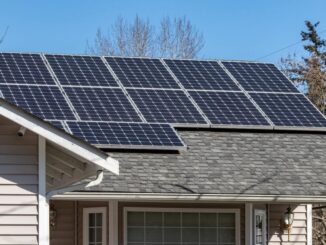By Richard Willoughby
Summary
This technical note examines the linkage between measured surface temperature and calculated solar electromagnetic radiation (EMR) available to the top of the atmosphere (ToA) that changes due to variation in Earth’s orbit.
Four regions are examined and analyzed using monthly averages for temperature and solar EMR available at ToA. Figure 1 shows the regions examined.
The regions are:
Central USA using GHCN temperature measurementsMediterranean Sea using NCEP/Reynolds Sea Surface (excludes land in the region)Nino34 region of the Equatorial Pacific using NCEP/ReynoldsSouthern Ocean 55S to 65S using NCEP/Reynolds (NCEP assumes water below ice is -1.8C)
For each region, the monthly measured time based data for temperature and calculated Solar EMR is displayed as well as correlations between the two. There are also time shifted correlations that indicate the thermal response of each region. The responses to solar forcing vary significantly but the correlations outside the tropics are high:
Central USA requires 13.5W/m^2 for each degree Centigrade; regression coefficient 97%The Mediterranean requires 28.5W/m^2 for each degree Centigrade; regression coefficient 96%The Nino34 region requires minus 40W/m^2 for each degree Centigrade; regression coefficient 14%The Southern Ocean requires 192W/m^2 for each degree Centigrade; regression coefficient 93%.
Both the solar EMR and surface temperature in the Nino34 region are subjected to frequency analysis to give insight into other factors that influence the surface temperature in addition to solar EMR.
Southern Ocean
The December Solar EMR at 60S peaked 3,800 years ago. It has been in decline since then. Figure 2 shows the monthly average temperature for both solar EMR and surface temperature for 55S to 65S for all longitudes.
Figure 3 examines the correlation between temperature and EMR.
There is a relatively weak positive correlation but there is indication of a phase shift.
Figure 4 shows how the correlation is dramatically improved by lagging the EMR two months relative to the measured surface temperature. It takes 192W/m^2 change in EMR to move the surface temperature 1C.
Mediterranean Sea
Average April solar EMR at 37N was at a minimum of 374W/m^2 5,000 years ago. It is now 387W/m^2. The April EMR will reach its next April peak of 399W/m^2 in 3,500 years from present. The following Figures 5, 6 and 7 show the EMR and temperature analysis for the Mediterranean Sea.
The linear correlation has a regression coefficient of 96%. A change of 28.5W/m^2 is required to shift the surface temperature 1C.
Central USA
Given the good correlations over ocean surfaces, it was considered educational to look at a region of land surface that has good coverage of reliable temperature records. Figures 8, 9 and 10 show the result.
The month-to-month correlation for the land surface is much better than for the ocean but there is an obvious loop. The best correlation is achieved with just 1 month lag.
The correlation of 97% for land is better than for ocean despite the much wider annual range in temperature for the same range in solar EMR; requiring only 13.5W/m^2 to move the surface temperature 1C.
Nino34 Region
The temperature response to EMR in the Nino34 region shown in Figure 11 is quite different to the higher latitudes so far considered.
It is clear that there is some annual cycling, but it is obviously poorly correlated with the EMR variation as shown in Figure 12.
It is notable that the correlation is negative. In fact the correlation is improved by advancing the EMR.
The regression coefficient of 14% indicates high confidence the correlation is negative. The fact that temperature leads EMR is consistent with negative feedback based on the surface temperature rather than the temperature actually controlling the sun.
The temperature trend in the region displays a definite longer-term beat, which shows up in the frequency analysis in Figure 14.
The annual peak is dominant but there are other broad peaks around 10.7 years and 22.3 years using just the temperature from the satellite era.
Figure 15 shows the frequency analysis for the calculated solar EMR based solely on the orbital geometry.
It is clear that there is no matching peak at a period around 11 years so it is concluded that the beat in the temperature record is not related to orbital changes.
Figure 16 shows the time variation of the temperature with monthly sunspot number.
There may be some correlation, but it is not clear in this graph. And the frequency analysis of the sunspot number shows peaks at periods similar to the temperature measurement.
The month-to-month correlation between temperature and sunspot numbers is insignificant per Figure 18 but becomes significant when the Sunspot number is lagged 31 months per Figure 19.
Conclusions
It has been demonstrated that land and ocean surface temperature are highly correlated to solar EMR in mid and higher latitudes; making due allowance for different thermal inertia of land and ocean.
It is further noted the observed trends in reliable surface temperature records can be forecast by the changing regional monthly solar EMR. Figure 20 shows how solar EMR has changed over the past 520 years and will change in the next 80 years at 30N.
Over the past 520 years, the April EMR has undergone the highest monthly increase at 30N and will continue to do so, increasing by almost 3W/m^2 over the 600 year time frame. In contrast, September EMR is in decline and will reduce by about 2.6W/m^2 over the 600 year period. Overall there is a slight upward trend in annual average EMR at 30N that will continue.
It has also been observed that land surface temperature responds in half the time and twice the range of latitudinal constrained deep water bodies such as the Mediterranean Sea for the same EMR variation. So it should be expected, as the solar EMR increases in the Northern Hemisphere, while reducing in the Southern hemisphere, the global average surface temperature will increase due to the higher proportion of land to water in the NH compared with the SH.
The average solar intensity over the Southern Ocean is in steady decline but the decline is most evident in November, which reduces the peak summer surface temperature. Figure 21 shows how the solar EMR has changed during the satellite era from 1980 to 2022 and will continue to change to 2040.
The Nino34 region is in a temperature limited region where temperature is negatively correlated with solar EMR. There is high probability that there are other solar factors in addition to orbital changes influencing the temperature in the region.
Data Sources
The data used to determine top of atmosphere reflected EMR were downloaded from NASA’s Earth Observation web site.
The data for GHCN land air temperature and NCEP measured SST were downloaded from the Climate Explorer website.
http://climexp.knmi.nl/start.cgi
The orbital parameters for determining the changes in ToA solar EMR came from the Astropicxels site:
Planetary Ephemeris Data (astropixels.com)
The data on sunspot number were sourced from the Royal Observatory of Belgium Sunspot Index and Long-term Solar Observations (SILSO) web site:
https://sidc.be/silso/datafiles
Although solar EMR was calculated from the orbital data, there is a useful reference source for determining insolation at nominated latitudes and months using the IMCCE insola web based model:
http://vo.imcce.fr/insola/earth/online/earth/online/index.php
The Author
Richard Willoughby is a retired electrical engineer having worked in the Australian mining and mineral processing industry for 30 years with roles in large scale operations, corporate R&D and mine development. A further ten years was spent in the global insurance industry as an engineering risk consultant where he developed an enduring interest in natural catastrophes and changing climate.



